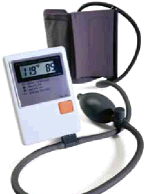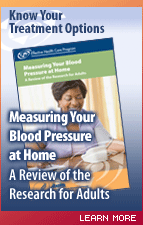- Home
- Search for Research Summaries, Reviews, and Reports
EHC Component
- EPC Project
Full Report
- Research Review Jan. 31, 2012
Related Products for this Topic
- Research Protocol Apr. 11, 2011
- Disposition of Comments Report Jun. 4, 2012
- Clinician Summary Feb. 22, 2012
- La Guías Sumaria de los Consumidores Apr. 24, 2012
- Executive Summary Jan. 31, 2012
Related Links for this Topic
Original Nomination
Consumer Summary – Feb. 22, 2012
Measuring Your Blood Pressure at Home: A Review of the Research for Adults
Formats
- View PDF (PDF) 564 kB
- Download Audio (MP3) 6.4 MB
- En Español
- Help with Viewers, Players, and Plug-ins
Table of Contents
- Is This Information Right for Me?
- Understanding Your Condition
- Measuring Blood Pressure
- Choosing a Home Blood Pressure Monitor
- Source
Is This Information Right for Me?
Yes, if:
A doctor* has told you that you may have high blood pressure, also called “hypertension.”
The doctor suggested that you check your blood pressure regularly at home.
You want to learn more about checking your blood pressure at home.
What will this summary tell me?
This summary will help you learn about measuring your blood pressure at home. It is created to help you and your doctor decide if checking your blood pressure at home is a good idea for you. This summary will also tell you about the research on blood pressure monitors and will give you questions to ask your doctor.
A review of 49 research studies was done for the Agency for Healthcare Research and Quality (AHRQ), a Federal research agency, to understand the benefits of self-measuring blood pressure. The report was reviewed by clinicians, researchers, experts, and the public. You can read the report at www.effectivehealthcare.ahrq.gov/selfmeasuredbp.cfm.
This summary will not tell you about medicines used to treat high blood pressure.
* The term “doctor” is used in this summary to talk about all the health care professionals that may take care of you, including your physician, nurse, nurse practitioner, or physician assistant.
Understanding Your Condition
What is high blood pressure?
High blood pressure, also called “hypertension,” is a serious medical condition. It happens when the force of the blood pumping through your arteries is too strong.
When your heart beats, it pushes blood through your arteries to the rest of your body. When the blood pushes harder against the walls of your arteries, your blood pressure goes up. Your blood pressure may be different at different times of the day. It is usually higher when you first wake up, after you exercise, or when you are under stress.
Having higher blood pressure for short amounts of time is normal. However, when your blood pressure stays high for most of the time, it can cause serious health problems.
How common is high blood pressure?
- High blood pressure is a common, chronic (ongoing) health condition.
- High blood pressure affects adults of all ages, but especially those over age 65.
- Around 76.4 million people in the United States have high blood pressure.
Lowering your blood pressure decreases your chance of heart attack, heart failure, stroke, and other health problems. About 7 million people die each year in the United States from illnesses caused by high blood pressure.
What problems can high blood pressure cause?
- Having high blood pressure for a long time can hurt your heart and lead to heart failure.
- Untreated high blood pressure can lead to heart attack, stroke, kidney failure, or other serious health problems.
Measuring Blood Pressure
How is blood pressure measured?
Usually, a cuff is filled with air to squeeze the artery in your upper arm while a “gauge” (measuring tool) records your blood pressure as the air is released from the cuff. Most home devices use digital (electronic) gauges.
What do the numbers mean?
A blood pressure measurement has two parts—a top (first) number and a bottom (second) number. The top number is the “systolic” (pronounced sis-TOL-ik) pressure and the bottom number is the “diastolic” (pronounced di-a-STOL-ik) pressure.
- Systolic pressure is your blood pressure when your heart beats and pumps blood through your arteries. Your blood pressure is higher while your heart is pumping, so the systolic number is higher.
- Diastolic pressure is your blood pressure in between heartbeats when your heart is not pumping. Your blood pressure is lower while your heart is not pumping, so the diastolic number is lower.
.png)
Your blood pressure numbers are given one on top of the other, with your systolic pressure “over” your diastolic pressure.
- A normal blood pressure is less than “120 over 80,” or 120/80. This means the systolic pressure is 120 and the diastolic pressure is 80.
- A blood pressure between 120/80 and 139/89 is called “prehypertension.” This means that your blood pressure is higher than normal and that you are at risk for having high blood pressure.
- If your blood pressure is 140/90 or higher most of the time it is measured, you have high blood pressure.
Why is blood pressure measured?
The only way to know if blood pressure is high is to regularly measure it several times a day over several months. High blood pressure itself may not have any symptoms, so it is important to regularly check your blood pressure even if it does not feel like it is high.
To help you better control your blood pressure, your doctor might suggest measuring your blood pressure at home. Your doctor can suggest the number of times to measure your blood pressure each day and at what times.
What does the research say?
- Measuring blood pressure at home helped some people lower their blood pressure by a small amount—about two or three points for both the top (first) and bottom (second) numbers. There was not enough research to see if the changes lasted beyond 6 months.
- People who had some kind of support from their doctor or health clinic when checking their blood pressure also improved their blood pressure control. There was not enough research to see if the changes lasted beyond 1 year.
- There is not enough research to say whether measuring blood pressure at home, with or without additional support (such as telephone call reminders or classes), helped people lower the number of medicines they had to take, the amount of each medicine they had to take, or the number of times they needed to see a doctor.
- Researchers cannot say what kind of additional support from a doctor or health clinic might be best to help people measure their blood pressure at home.
What devices are available to measure my blood pressure at home?
If you and your doctor think that measuring your blood pressure at home is a good idea, you will need to purchase the equipment. You can buy a home blood pressure monitor without a prescription from pharmacies or other stores that sell medical supplies. Several stores on the Internet also sell home blood pressure monitors. There are different styles of monitors, but they all have the same main parts:
- A cuff that fits around your arm. The cuff may fill with air automatically from the machine, or you will need to pump air into the cuff.
- A gauge dial with numbers and a pointer or a digital display that shows your blood pressure reading.
Some blood pressure monitors have a “stethoscope” (the instrument your doctor uses to listen to your heart). Not all monitors need a stethoscope to measure blood pressure.
There are three types of home blood pressure monitors.
Automatic monitors
.png)
- You turn this monitor on by pushing a button. The cuff inflates by itself.
- It detects your blood pressure as the cuff deflates and displays the measurement for you.
Semi-automatic monitors

- With a semi-automatic monitor, you inflate and deflate the arm cuff yourself. It displays a digital reading of your blood pressure.
Manual monitors

- You inflate the arm cuff by pumping a rubber bulb attached to the cuff by a tube.
- You then use a stethoscope to listen to the sounds of the blood flowing through your artery as you let the pressure in the cuff slowly go down.
Choosing a Home Blood Pressure Monitor
Which monitor works best?
There is not enough research to say whether one type of home monitor works better than another to accurately measure your blood pressure. How well a monitor works may depend on how well you know how to use it. Bring your monitor to your doctor or nurse so that he or she can:
- Show you how to use it.
- Check the monitor to make sure it gives the same measurement.
What is important to consider when choosing a monitor?
- The monitor should have clear instructions and be easy to use.
- The cuff needs to fit your arm properly. If the cuff does not fit right, it will not give a correct reading. You may want to check before buying the monitor to make sure the cuff is not too large or too small for your arm.
- The gauge or display on the monitor should be large enough so you can clearly see it.
- If the monitor comes with a stethoscope, it should fit into your ears so you can hear clearly. You will need to know what the sounds mean. Ask your doctor or nurse about how to use a stethoscope.
How much do home blood pressure monitors cost?
Home blood pressure monitors cost about $40 to $150. Basic manual monitors usually cost the least.
Automatic monitors with advanced features (like the ability to save readings, print them out, or electronically send them to your doctor) are more expensive. Your health insurance may not cover the cost of a home monitor, so check with your health plan about what types or brands may be covered, if any.
Ask your doctor
Your doctor can help you decide if measuring your blood pressure at home may help you. Ask your doctor:
- Do you think that measuring my blood pressure at home can help me better control my blood pressure?
- Can you or someone in your office show me how to use my blood pressure monitor? If not, where can I learn how to use it correctly?
- How many times a day or week should I check my blood pressure?
- Are there better times of the day than others to check?
- Should I record the numbers every time I check?
- Do you want to see the numbers?
- Should I change the amount of medicine I take because of my numbers?
- What kind of numbers would tell me that I need to come and see you or go get immediate help?
Source
The information in this summary comes from the report Self-Measured Blood Pressure Monitoring: Comparative Effectiveness, January 2012.
The report was produced by the Tufts University Evidence-based Practice Center through funding by the Agency for Healthcare Research and Quality (AHRQ).
For more information about AHRQ and the Effective Health Care Program, go to: http://www.effectivehealthcare.ahrq.gov/index.cfm/what-is-the-effective-health-care-program1/. Additional information came from the MedlinePlus® Web site, a service of the National Library of Medicine and the National Institutes of Health. This site is available at www.nlm.nih.gov/medlineplus.
This summary was prepared by the John M. Eisenberg Center for Clinical Decisions and Communications Science at Baylor College of Medicine, Houston, TX. It was written by Geetha Achanta, Ph.D., Amelia Williamson Smith, M.S., Thomas Workman, Ph.D., Sarah Michel, M.P.H., James Pool, M.D., and Michael Fordis, M.D. Patients with high blood pressure reviewed this summary.
Return to Top of Page

 E-mail Updates
E-mail Updates

